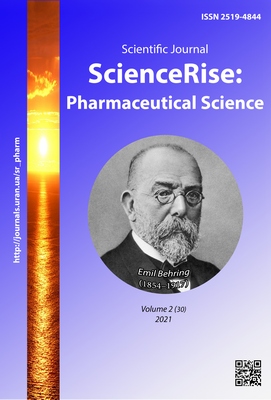Структурний аналіз обсягів державних витрат на закупівлю протитуберкульозних лікарських препаратів
DOI:
https://doi.org/10.15587/2519-4852.2021.230028Ключові слова:
мультирезистентний туберкульоз, протитуберкульозні лікарські препарати, державні витрати, економічний аналіз, темпи приростуАнотація
Мета: проведення структурного аналізу обсягів державних витрат на закупівлю протитуберкульозних лікарських препаратів у період 2014–2018 рр.
Матеріали і методи. У дослідженнях використовувалися дані державних закупівель протитуберкульозних лікарських препаратів за 2014–2018 рр., що представлені на сайті МОЗ України у розділі «Закупівлі ліків», а також статистичні дані «Центру громадського здоров’я МОЗ України» щодо показників захворюваності населення на мультирезистентний туберкульоз. Застосовувалися аналітико-порівняльний, системний, логічний, а також методи економічного аналізу. За допомогою синтезу сформовані висновки та рекомендації.
Результати дослідження. Встановлено, що за 2014–2018 рр. темп приросту захворюваності на мультирезистентний туберкульоз має позитивну динаміку щодо зменшення кількості зареєстрованих випадків. Так, у 2015 р. цей показник мав значення 2,56 %, а у 2018 р. склав -7,93 %.
Доведено, що державна закупівля лікарських препаратів у натуральному вимірі має хаотичний характер. Так, за 2015/2014 рр. темп приросту кількості ПТЛП склав 35,55 %, 2016/2015 рр. – -31,59 %, 2017/2016 рр. – 15,31 %, 2018/2017 рр. – 6,13 %. З’ясовано, що динаміка темпів приросту обсягів закупівель ПТЛП у національній валюті та дол. США має певні розбіжності. Так, у 2015 р. у національній валюті відбувався приріст витрат на 55,02 %, а у доларовому еквіваленті цей показник зменшився на 15,64 % порівняно з 2014 р. Водночас, у 2018 р. спостерігалась позитивна тенденція збільшення обсягів державних витрат у грошовому виміру. Так, у 2018 р. темп приросту у національній валюті склав 53,16 %, а у дол. США – 49,83 %.
Доведено, що у структурі державних витрат спостерігається тенденція незначного превалювання протитуберкульозних лікарських препаратів іноземного виробництва. За даними співставного аналізу державних витрат на групи протитуберкульозних лікарських препаратів за пріоритетністю їх застосування у схемах лікування відповідно до стандартів встановлено, що процес закупівель протитуберкульозних лікарських препаратів не відповідає критеріям пріоритетності при лікування, що ускладнює впровадження процесу реформування протитуберкульозної допомоги у зв’язку із побудовою амбулаторної моделі.
Посилання
- Kotvitska, A., Prokopenko, O. (2020). Determination of social and economic accessibility of drugs for treatment of Parkinson’s disease on the basis of modern approaches. Pharmacia, 67 (3), 173–179. doi: http://doi.org/10.3897/pharmacia.67.e46586
- Samborskyi, O., Slobodyanyuk, M., Panfilova, Н. (2020). Comparative analysis of the dynamics of healthcare expenditures from country GDP and cash payments of families to medical and pharmaceutical support in Ukraine, CIS countries and ЕU. ScienceRise: Pharmaceutical Science, 3 (25), 20–27. doi: http://doi.org/10.15587/2519-4852.2020.206569
- Pakdaman, M., Geravandi, S., Askari, R., Askarishahi, M., Afzali, R. H. (2019). The effect of macroeconomic indica-tors on health-care expenditure in Iran. Journal of Education and Health Promotion, 8 (1), 123.
- Pro skhvalennia Kontseptsii Zahalnoderzhavnoi tsilovoi sotsialnoi prohramy protydii zakhvoriuvanniu na tuberkuloz na 2018–2021 roky (2017). Rozporiadzhennia Kabinetu Ministriv Ukrainy No. 1011-r. 27.12.2017. Available at: https://zakon.rada.gov.ua/laws/show/1011-2017- %D1 %80#Text
- World Health Organization. Regional Office for Europe. (2019). Tuberculosis surveillance and monitoring in Europe 2019: 2017 data. Available from: https://apps.who.int/iris/handle/10665/311349
- Tuberculosis (2020). World Health Organization: WHO. Available at: https://www.who.int/news-room/fact-sheets/detail/tuberculosis
- Mase, S., Chorba, T., Parks, S., Belanger, A., Dworkin, F., Seaworth, B. et. al. (2019). Bedaquiline for the Treatment of Multidrug-resistant Tuberculosis in the United States. Clinical Infectious Diseases, 71 (4), 1010–1016. doi: http://doi.org/10.1093/cid/ciz914
- Lange, C., Aarnoutse, R. E., Alffenaar, J. W. C., Bothamley, G., Brinkmann, F., Costa, J. et. al. (2019). Management of patients with multidrug-resistant tuberculosis. The International Journal of Tuberculosis and Lung Disease, 23 (6), 645–662. doi: http://doi.org/10.5588/ijtld.18.0622
- Feshchenko, Yu. I., Melnyk, V. M., Turchenko, L. V. (2015). A concept of reformation of tuberculosis healthcare system and optimization of anti-tuberculosis activity in Ukraine (project). Ukrainskyi pulmonolohichnyi zhurnal, 1 (87), 5–9.
- Feshchenko, Y. I. (2019). Up-to-date tendencies in tuberculosis research. Ukrainian Pulmonology Journal, 1, 8–24. doi: http://doi.org/10.31215/2306-4927-2019-103-1-8-24
- Feshchenko, Y. I., Lytvynenko, N. A., Varytska, H. O., Chobotar, O. P., Pohrebna, M. V., Senko, Y. O. et. al. (2017). Prospects for improving the treatment efficacy for patients with multidrug resistant tuberculosis: global trends and national advances. Infectious Diseases, 4, 10–21. doi: http://doi.org/10.11603/1681-2727.2017.4.8418
- Tsentr hromadskoho zdorovia MOZ Ukrainy. Available at: https://phc.org.ua
- Feshchur, R. V., Barvinskyi, A. F., Kichor, V. P. (2003). Statystyka: teoretychni zasady i prykladni aspekty. Lviv: Intelekt-Zakhid, 576.
- Pro zatverdzhennia standartiv okhorony zdorovia pry tuberkulozi (2020). Nakaz MOZ Ukrainy No. 530. 25.02.2020. Available at: https://phc.org.ua/sites/default/files/users/user90/Nakaz_MOZ_vid_25.02.2020_530_Standarty_medopomogy_pry_TB.pdf
- Zvedena nastanova VOOZ z tuberkulozu. Modul 4: likuvannia Likuvannia likarsko-stiikoho tuberkulozu. Available at: https://phc.org.ua/sites/default/files/users/user90/WHO %20consolidated %20guidelines %20on %20tuberculosis %20Module %204 %20Treatment %20Drug-resistant %20tuberculosis %20treatment_UKR.pdf
- Global tuberculosis report 2018 (2018). Geneva: World Health Organization. Available at: https://apps.who.int/iris/bitstream/handle/10665/274453/9789241565646-eng.pdf
- Sadova, D. T., Hrom O. L. (2009). Klasternyi analiz vplyvu medychnykh, demohrafichnykh ta sotsialno-ekonomichnykh chynnykiv na zakhvoriuvanist tuberkulozom. Farmatsevtychnyi chasopys, 2, 53–56.
- Oleshchuk, O. M., Piniazhko, O. B., Kovtun, L. І., Serediuk, V. V., Masheiko, А. М., Topachevskyi, O. A. (2020). Update of recommendations concerning development of the scale of budget impact rate in the evaluation of the purchase of medicines in Ukraine as for 2019 data. Pharmaceutical Review, 2, 76–83. doi: http://doi.org/10.11603/2312-0967.2020.2.11256
- Prilipko, N. A. (2014). Problematic issues of the pharmaceutical component of the national target social program to combat the incidence of tuberculosis for 2012–2016. Pharmaceutical Review, 3, 71–74.
- Pedrazzoli, D., Boccia, D., Dodd, P. J., Lönnroth, K., Dowdy, D. W., Siroka, A. et. al. (2017). Modelling the social and structural determinants of tuberculosis: opportunities and challenges. The International Journal of Tuberculosis and Lung Disease, 21 (9), 957–964. doi: http://doi.org/10.5588/ijtld.16.0906
##submission.downloads##
Опубліковано
Як цитувати
Номер
Розділ
Ліцензія
Авторське право (c) 2021 Iuliia Korzh, Tatyana Romanko, Tatyana Romanko, Alina Volkova, Lubov Tereshсhenko

Ця робота ліцензується відповідно до Creative Commons Attribution 4.0 International License.
Наше видання використовує положення про авторські права Creative Commons CC BY для журналів відкритого доступу.









